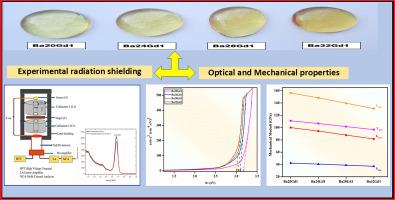Optical properties and radiation shielding performance of BaO-content modified CaO-ZnO-Gd2O3-B2O3 glasses
IF 5.7
3区 材料科学
Q2 MATERIALS SCIENCE, MULTIDISCIPLINARY
引用次数: 0
Abstract
This work presents the fabrication and comprehensive characterisation of novel glasses of composition:(80-x)B2O3–8CaO-11ZnO-xBaO-1Gd2O3 (x = 20, 24, 28 and 32) via the melt-quenching technique. XRD and FTIR analyses confirmed their amorphous structure and vibrational modes of the glasses. Optically, the direct band gap drops from 3.173 to 3.006 eV, while Urbach energy increases from 0.268 to 0.357 eV, reflecting enhanced disorder and electronic polarizability. Mechanically, both dissociation energy (74.043 to 68.847 kJ/cm3) and Young’s modulus (111.051 to 96.692 GPa) indicate reduced structural cohesion due to weaker Ba-O bonds. Furthermore, experimental shielding capabilities were investigated using a NaI(Tl) detector and radioactive gamma sources. Mass and linear attenuation coefficients, effective atomic number, mean free path, half-and tenth-value layers were determined using Phy-X/PSD and XCOM. The results reveal significant enhancements in physical, mechanical, optical tunability and radiation attenuation efficiency with increasing BaO composition, highlighting the potential of these glasses in photonic and radiation protection applications.

含bao改性CaO-ZnO-Gd2O3-B2O3玻璃的光学性能及辐射屏蔽性能
本文介绍了一种新型玻璃的制备和综合表征,该玻璃的成分为:(80-x) B2O3-8CaO-11ZnO-xBaO-1Gd2O3 (x = 20, 24, 28和32)。XRD和FTIR分析证实了玻璃的非晶结构和振动模式。光学上,直接带隙从3.173 eV下降到3.006 eV,而乌尔巴赫能量从0.268 eV增加到0.357 eV,反映了无序性和电子极化率的增强。机械上,解离能(74.043 ~ 68.847 kJ/cm3)和杨氏模量(111.051 ~ 96.692 GPa)表明,由于Ba-O键较弱,结构内聚力降低。此外,利用NaI(Tl)探测器和放射性伽玛源研究了实验屏蔽能力。利用Phy-X/PSD和XCOM测定质量和线性衰减系数、有效原子序数、平均自由程、半值层和十值层。结果显示,随着BaO成分的增加,这些玻璃的物理、机械、光学可调性和辐射衰减效率显著增强,突出了这些玻璃在光子和辐射防护方面的应用潜力。
本文章由计算机程序翻译,如有差异,请以英文原文为准。
求助全文
约1分钟内获得全文
求助全文
来源期刊

Materials Research Bulletin
工程技术-材料科学:综合
CiteScore
9.80
自引率
5.60%
发文量
372
审稿时长
42 days
期刊介绍:
Materials Research Bulletin is an international journal reporting high-impact research on processing-structure-property relationships in functional materials and nanomaterials with interesting electronic, magnetic, optical, thermal, mechanical or catalytic properties. Papers purely on thermodynamics or theoretical calculations (e.g., density functional theory) do not fall within the scope of the journal unless they also demonstrate a clear link to physical properties. Topics covered include functional materials (e.g., dielectrics, pyroelectrics, piezoelectrics, ferroelectrics, relaxors, thermoelectrics, etc.); electrochemistry and solid-state ionics (e.g., photovoltaics, batteries, sensors, and fuel cells); nanomaterials, graphene, and nanocomposites; luminescence and photocatalysis; crystal-structure and defect-structure analysis; novel electronics; non-crystalline solids; flexible electronics; protein-material interactions; and polymeric ion-exchange membranes.
 求助内容:
求助内容: 应助结果提醒方式:
应助结果提醒方式:


